The Aesthetic Spirit of Barcelona: the Sagrada Familia
- Yunxiao Chen
- May 13, 2022
- 4 min read
“Compared to other architectures we visited in Spain, the Sagrada Familia is so different,” said Andrei, a German tourist who came to Spain with his wife Monica, “We are not religious, just enjoy appreciating a variety of architecture.” Indeed, you don’t need to be religious to be touched by great artworks initially created for religious purposes. Real art is for almost everyone—as an ordinary tourist with even no knowledge of Christianity can still attempt to have a taste of its glamour. It is not just a church, but a universal symbol of faith.
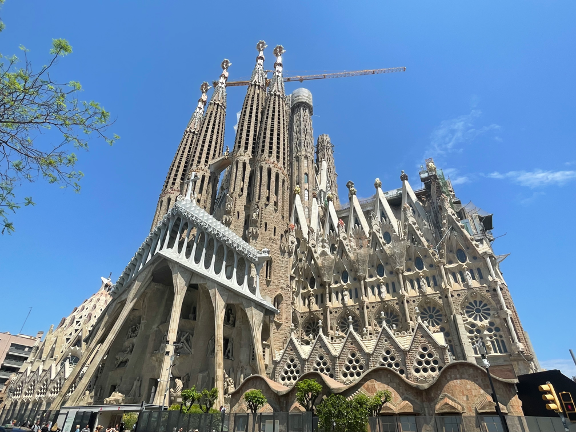
The three portals of this façade are named Hope, Mercy, and Faith- three pillars of Catholic dogma‘
The Sagrada Familia naturally sticks out like a towering banian surrounded by relatively low buildings. In Barcelona, skyscrapers and other high-rise buildings are very rare, which sets off the temple very well. When you approach the Sagrada Familia, slowly raise your head, and perhaps be careful of the bright sun near the top which seems to empower this construction during the day.
The American architecture critic Paul Goldberger describes the Sagrada Familia as “’the most extraordinary personal interpretation of Gothic architecture since the Middle Ages”. It's not just the scale that's surprising, but the exterior and structure that most people might not expect—it likes an alien out of this world. The colorful offerings of fruits are adorned as the Eucharistic symbol, the inconsistent conditions of different parts, and seemingly disparate styles of the tower of the Virgin Mary and the main part of the Temple…The more time you dedicate to observing it, the more delicate details you may spot.
“This church is quite different from others in Spain. I think it is right the landmark makes Spain so different,” said Martí Guardiola, a security guard worked in the temple for just one week, “But it is also quite common that I saw many people think the appearance of it is weird.” If you find it difficult to appreciate, there is nothing wrong. Take a breath, relax your mind, get closer, and try to see if there are a variety of details touch you.

Colorful stuff like the fruit topped the tower of the Virgin Mary (left) and the cypress tree on the portal of Charity of the Nativity Façade (right) appears very fresh against the raw colors around it
About 1866, a congregation of devotees of Mary's husband and the earthly father of Jesus, St. Joseph, proposed to construct a temple in memory of him. Josep Maria Bocabella i Verdaguer, a Barcelona-born merchant and devout Catholic who had been impressed by a Sanctuary of the Holy House in Loreto, contemplated the idea of making a replica of it which then become the Basilica. In the beginning, the diocesan architect Francisco de Paula del Villar was responsible for the project. He followed the predominant aesthetic principles of the prevalent neo-Gothic style. The neo-Gothic style was generated from the “Gothic Revival” movement in the middle of the 18th century in England. It gained popularity in Europe around the 19th century. The neo-Gothic ideas were influenced by Medieval architecture which avoided symmetry, using vertical framing and highly decorated corner gables. Classical characteristics of neo-Gothic architecture are the pointed bell tower, flying buttresses, the large ogival, and cloisonné windows. There are plentiful neo-Gothic architectures in Catalonia, such as Sagrat Cor Church, Sant Francesc de Sales Church, and Facthe ade of Barcelona Cathedral.

Gaudi imbued the temple with fantastic geometric elements
By and large, the overall idea of Gothic architecture is about magnificence and grandeur. Despite the crowd on the ground, the ample space of the church produced an unshakable silence.
Antonio Gaudi took over the project around 1833. Before taking his place, there was a disagreement between del Villar and the principal advisor of Bocabella on the material expense in terms of techniques that resulted in the step-down of del Villar. At that time, Gaudi was just 31-year-old and had already built up a reputation in the field. Devoted more than 40 years to the construction of the Sagrada Familia, Gaudi converted the Sagrada Familia into a huge Bible in stone. He also turned the original neo-gothic project into a more modern and “bizarre” one.
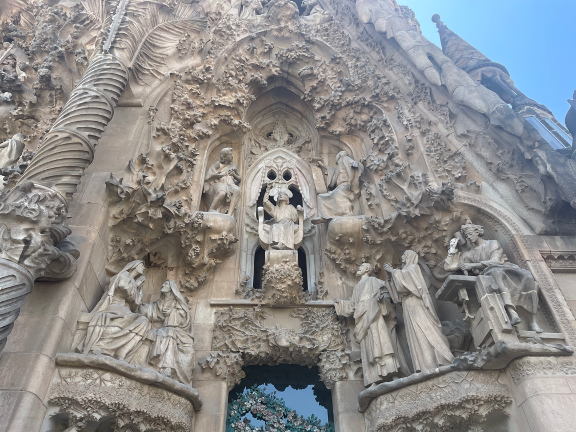
One part of the Nativity Facade that refers to the story of Christ
When stepping inside the church, the stained glass will probably be the first thing you notice. As the glittering decorations, the stained glass is an irresistible temptation of Western art from medieval times to modern times. It is actually a form of painting that can be traced back 1,000 years ago.

Stained glass derives from the silver stain that was usually applied to the outside of the window
Great artistic achievement often comes from breaking rules. Gaudi sought to transcend the existing Gothic style, so he didn’t follow the general distribution of Gothic stained glass: the most colorful part at the highest and less intense in lower sections. He set the purely transparent glass highest that can let the light flow in, illuminating the nave featured by the mosaics and golden vaults.
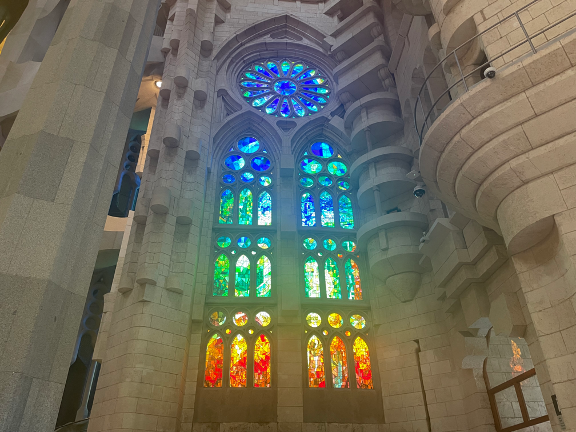
Gaudi chose the leaded glass where the lead lines were laid down between the small pieces of glass that can break down the color and give a sensation of depth
Then it was the visual artist Joan Vila-Grau who accomplished the design of the stained glass that we see today. He followed Gaudi’s intention and studied the path of the sun rays, then created the effect of the sun filtering through the leaves on the colored window.

Enchanting light streaming into the Basilica
Gaudi was a sincere nature admirer. The interior of a majority of European churches is relatively dark, which is an important reason why Gothic churches utilize rectangular windows to facilitate light. The Sagrada Familia, on the other hand, is forest-inspired, with white vaults supported by columns that resemble tall trees. Even on rainy days, the stained glass allows light to enter the spacious, bright interior as if God had sheltered the world.
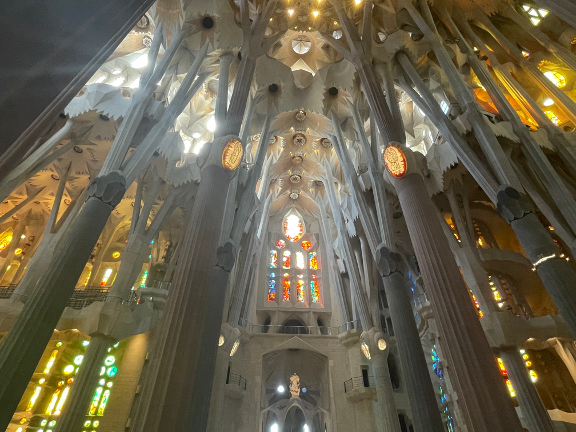
The interior of the Sagrada Familia with high ceilings and tree-like interior columns
In modern cities, Gothic and neo-Gothic urban architecture functions as a means of self-identification of European culture. Stephen Pan, a graphic designer in China, expressed his great passion for the Sagrada Familia, “It is my lover. I can stay here all day.”
This unparalleled construction is expected to be completed in 2026, let us imagine how wonderful it will be to witness the completion of a project spanning nearly two centuries. But if you haven’t been there yet, you might as well get a look at this human miracle.
See more scenes of the Temple below:



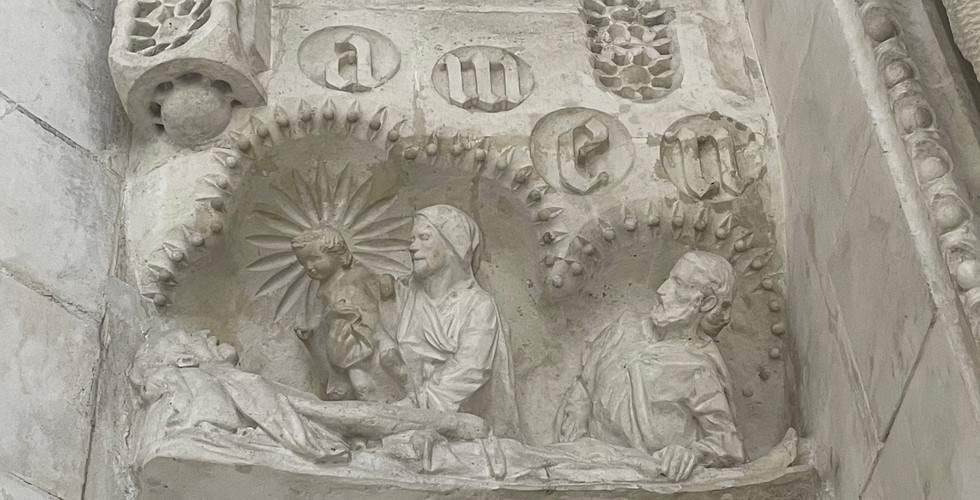









Comments